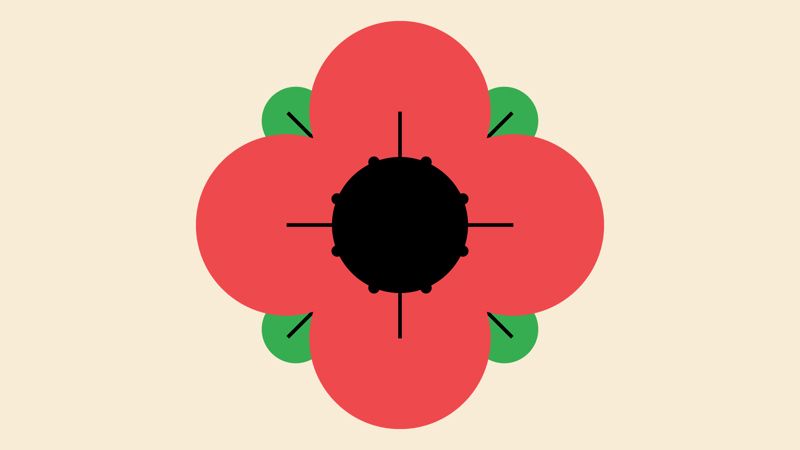
Paint Remembrance pebbles
You’ll need
- Paint
- Paint brushes
- Access to water
- Pens or pencils
- Stones or pebbles
- Paint pots
- Tables (optional)
- Chairs (optional)
- Thick card
Remembrance honours people who serve to defend our democratic freedom and way of life. We unite across faiths, cultures and backgrounds to remember the service and sacrifice of the Armed Forces community from the United Kingdom and the Commonwealth. We will remember them.
- We remember the sacrifice of the Armed Forces community from the United Kingdom and the Commonwealth.
- We pay tribute to the special contribution of families and of the emergency services.
- We acknowledge innocent civilians who’ve lost their lives in conflict and acts of terrorism.
Remembrance doesn’t glorify war and its symbol, the red poppy, is a sign of both Remembrance and hope for a peaceful future. Wearing a poppy isn’t compulsory but it’s greatly appreciated by those who it’s intended to support. When and how you choose to wear a poppy reflects your individual experiences and personal memories.
Remembrance unites people of all faiths, cultures and backgrounds, but it’s also deeply personal. It could mean wearing a poppy in November, joining with others in your community on a commemorative anniversary, or taking a moment on your own to pause and reflect. Everyone’s free to remember in their own way or to choose not to remember at all.
- Armistice Day is the 11 November. It marks the armistice agreement that bought an end to the fighting of the first world war.
- People pause at 11am on the 11 November to remember service and sacrifice past and present.
- The national service of Remembrance happens on the closest Sunday to 11 November, which is known as Remembrance Sunday. Each year people gather at the Cenotaph in London and other memorial sites.
- We call the whole period around these dates Remembrance. There are many ways to take part in Remembrance
In 2022, the Royal British Legion remembers the Service of those who work to protect us and our ways of life. Whether in the Armed Forces, Emergency or Civilian Services, past or present, we remember who has served, how they served and why it’s important that we continue to remember them.
Before you begin
- Use the safety checklist to help you plan and risk assess your activity. Additional help to carry out your risk assessment, including examples can be found here. Don’t forget to make sure all young people and adults involved in the activity know how to take part safely.
- Make sure you’ll have enough adult helpers. You may need some parents and carers to help if you’re short on helpers.
Preparing for crafting
- Decide whether you’ll use chairs and tables.
- Put out a pebble per person, pencil, some paint, paintbrushes and a pot of water to clean the brushes on each table or in each area.
- Draw a landscape or a message of remembrance on the piece of card. This'll become the centre of the group’s final creation.
- You can paint it yourself or leave it for someone to do during the meeting.
It's time to paint
- Everyone should sit at one of the spaces at the table or on the floor.
- Everyone should chat about Remembrance. Talk about why it happens, what it means and how people usually mark the occasion. People’s ideas may include parades, visiting the local war memorial or two minute silences.
- The person leading the activity should explain that making a pebble to remember is just one other way to remember everyone who died in war.
- Everyone should draw the outline of a poppy on their pebble. If you need to, you could print out some pictures of the poppy for people to copy.
- Once people are happy with their outline, everyone should get stuck in with paints.
- When everyone is finished, place the pebbles somewhere out of the way to dry, such as on a windowsill or table.
- While the pebbles are drying, you could read a poem, such as In Flanders Fields by John McCrae or A Scout in Flanders by H.E. Afterwards, chat about what it means.
- When the pebbles are dry, everyone should pick up their pebble and take it in turns to place it around the picture or phrase on the card.
- Everyone should decide how on you should display your group's creation. You could leave it somewhere people can see, take a picture to display or rebuild it somewhere else.
- Make sure you’ve been given permission from the landowner or council, and think about how you’ll keep your creation safe from the weather. If you did the activity online, people could put their pebble in a window or drop it off somewhere.
Reflection
This activity gave everyone the chance to think a bit more about the poppy. Do people usually see lots of poppies around in November?
Did anyone already know what they meant and what they symbolised? Do people think it’s helpful to have a shared symbol like a poppy for important things like Remembrance?
In this activity, everyone thought about Remembrance and how it links to their lives. What did people find out about Remembrance? How did it make them feel? How are people going to take part in Remembrance this year?
Safety
All activities must be safely managed. You must complete a thorough risk assessment and take appropriate steps to reduce risk. Use the safety checklist to help you plan and risk assess your activity. Always get approval for the activity, and have suitable supervision and an InTouch process.
People could help draw and paint the centre picture or message once they've finished painting their pebble. People could also create their own mini picture, made up of lots of different pebbles.
Not everyone has to read a poem by themselves, someone could read it out to the group and people can listen. People should feel free to ask if they don’t understand any of the words.
All Scout activities should be inclusive and accessible.
If you want to explore Remembrance further and create your own Remembrance event with A Remembrance reflection.
Let young people decide what picture or message they have in the middle of their picture, even if there’s no time for them to make it themselves.


